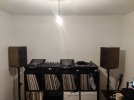Harryharryharry
Active Member
- Joined
- Mar 13, 2021
- Messages
- 148
- Likes
- 63
Hello!
I've just moved house and getting my office/music room setup.
The room is about 2.6m x 2.8m (decks currently on the 2.6m side. One of the 2.8m sides has french doors on.
I've currently got some Kef R3s, minidsp flex & topping PA5 and SVS Sb1000pro which is pretty killer, however:
- The kefs are large and heavy for a small room
- I've only got crappy tall stands for them
- Wall mounting would be tricky and probably not advised for them to be that close to the wall
- I like pointing the theaters at my ears when mixing (this means they're right on the corner which probably isn't ideal).
- I'm going to move the decks opposite my desk so I'd like them to also be flat to the wall for background music
Whilst I love the setup it seems suboptimal for this room.
Should I persevere and try for stands or wall mounting or consider a new setup?
I'm coming round to Genelecs especially with GLM, but they are very expensive. 8331s are around £3,500+ extras.
Anything else you'd recommend consider ideally on par or better performance?
I've just moved house and getting my office/music room setup.
The room is about 2.6m x 2.8m (decks currently on the 2.6m side. One of the 2.8m sides has french doors on.
I've currently got some Kef R3s, minidsp flex & topping PA5 and SVS Sb1000pro which is pretty killer, however:
- The kefs are large and heavy for a small room
- I've only got crappy tall stands for them
- Wall mounting would be tricky and probably not advised for them to be that close to the wall
- I like pointing the theaters at my ears when mixing (this means they're right on the corner which probably isn't ideal).
- I'm going to move the decks opposite my desk so I'd like them to also be flat to the wall for background music
Whilst I love the setup it seems suboptimal for this room.
Should I persevere and try for stands or wall mounting or consider a new setup?
I'm coming round to Genelecs especially with GLM, but they are very expensive. 8331s are around £3,500+ extras.
Anything else you'd recommend consider ideally on par or better performance?

